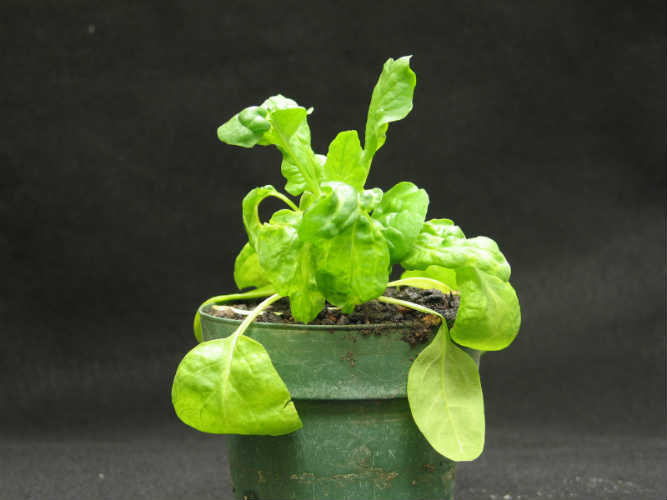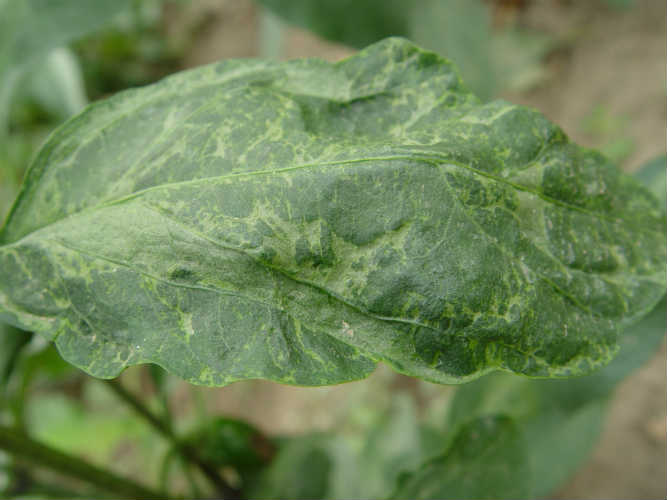Basic Information | Advanced Information | Diagnostic Information
Tomato Diseases | Cucumber Mosaic Virus
Cucumber Mosaic Virus
Descriptions of Plant Viruses Website provides extensive information about viruses, viroids, and more including descriptions, taxonomic notes, and sequence analyses.
Identification
Symptoms on tomatoes vary greatly with host variety, viral strain, time of infection, light intensity, and other environmental conditions.
Leaves:
The most characteristic viral symptom is the light and dark green mosaic pattern on the foliage. There may also be yellow spotting or streaking on the leaves and interveinal chlorosis, meaning there is a distinct yellowing in the veins of the leaves. The leaves may also become twisted and curl downward and exhibit “shoestringing” of “filiformity,” in which there is a reduction of leaf blades along the main vein of the leaf. When shoestringing is severe, the leaves resemble rat-tails.
Foliar symptoms of CMV on tomato plants (left), lettuce (center), and pepper (right).
Fruits:
When immature fruits are infected, they may develop internal browning caused by a collapse in cells. Overall, diseased plants are stunted, have slowed growth, and produce small quantities of fruit with necrosis and delayed maturity. In peppers, fruits may be smaller than normal, and wall thickness may be reduced.


Symptoms of CMV on pepper and jalapeño pepper.
Pathogen Biology
Cucumber mosaic virus overwinters in perennial weeds and other volunteer plants, which serve as the primary inoculum for new season infection. Seeds can also be a source of inoculum, but are unlikely. Cucumber mosaic virus particles enter a host through wounds or natural openings. The virus particles penetrate the host cells and shed the protective protein coat to expose three genomic, single-stranded, positive sense RNAs. The host’s machinery then begins to translate RNA and synthesize the viral proteins and nucleic acids. The virus assembles itself into a mature virus particle and moves to other cells and eventually systemically to other parts of the plant. The virus spreads from plant to plant primarily by its aphid vector. More than 80 aphid species can transmit this disease in a nonpersistent manner, meaning that the insect acquires the virus in short probes and retains the virus for short periods of time, losing the virus gradually through normal feeding activities. The virus particles are unstable in the environment and do not survive for long periods of time outside a host, so they are unlikely to be transmitted by workers during field operations. However, transmission rate varies with aphid species, viral strain, host species, and environmental conditions.
Favorable Environmental Conditions
Conditions that support aphid movement and feeding promote spread of the disease. In general, these conditions are temperatures between 70-85ºF; anything warmer or colder than this range slows down the reproduction of the aphids. Note that the stressful conditions for the plants also cause stress on the vectors.
Often Confused With
- Tomato mosaic virus causes mottling and mosaic, necrosis, stunting, leaf curling, and yellowing of plant tissues and can also cause deformed fruits, uneven fruit coloring, and delayed fruit ripening.
- Herbicide damage causes leaf deformations resembling cucumber mosaic virus on tomato plants.
Scouting Notes
Scout high tunnels for first occurrence of disease symptoms and where applicable, remove and destroy the infected plants. Monitor aphid populations early in the season and apply insecticides if needed.
Thresholds
Currently, there is no threshold information for CMV.
Management Notes
- No tomato varieties with CMV resistance have been released or are available.
- Sanitation is the primary means to controlling the disease. Any tools for pruning or cutting for tomato plants must be sanitized in order to reduce mechanical transmission of the pathogen. Many plant viruses are inactivated by dipping tools in a dilute chlorine bleach solution or in dilute milk. If infected tomato plants are found, remove and destroy them. Removal of weed hosts may delay virus infection but is proven to be a difficult task because of the extensive host range of the virus.
- Insecticides may be used to control aphid populations, but this does not necessarily result in effective CMV management. This is due to 1) the rapid, almost immediate transmission of CMV by aphids visiting and probing plants, 2) the rapidly increasing population of aphids throughout a season and 3) the large number of aphid species that can vector this particular disease.



